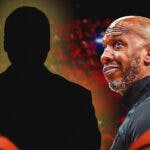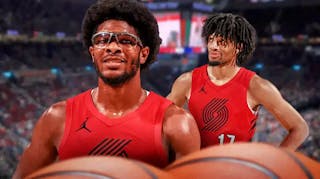There were times last season when Jusuf Nurkic took matters into his own hands defensively for the Portland Trail Blazers. Terry Stotts didn't outright forbid Nurkic from veering outside Portland's ultra-conservative defensive scheme, even encouraging his random forays to the perimeter with a simple caveat.
“Sometimes Nurk goes rogue,” Stotts said after the Blazers beat the Orlando Magic on March 26th last season, Nurkic's first game in 10 weeks. “As long as it works, it's fine.”
The stifled laugh and flushed face of Portland's longtime coach was most telling, though. Randomly “going rogue” wouldn't be a nightly staple of Nurkic's defensive approach for the Blazers, at least if he wanted to peacefully coexist with Stotts. Nurkic mostly obliged what Stotts didn't say over the season's remainder. After Portland was bounced from the first round of the playoffs in six games by the short-handed Denver Nuggets, though, Nurkic made his feelings on playing under Stotts' two-way strategies abundantly clear.
Anyone who's been paying attention isn't surprised by Nurkic so quickly warming to Chauncey Billups and the Blazers' coaching staff. Not only does Portland's rookie head coach want to further unlock Nurkic's playmaking prowess and feed him a steady diet of touches down low. The more active, aggressive defensive system being implemented by Billups aligns with how Nurkic has preferred to play for years, too.
“We are trying to stop the guard from turning the corner and getting downhill into our defense,” Billups said of the Blazers' ball-screen defense after the first day of training camp, per Jason Quick of The Athletic.
Portland's excitement for that change in approach extends beyond Nurkic. Lillard said following Tuesday's practice that he likes the Blazers' new defense “a lot,” and his teammates expressed enthusiasm at Media Day about homing in on the finer points of a system that demands collaboration and precision—not to mention accountability.
There's not much room for Portland, the league's second-worst defense last season, to somehow fare worse on that end in 2021-22. But team-wide optimism and a palpable desire to get better defensively will only help the Blazers string together stops so much once the regular season tips off. Portland still suffers from inherent personnel deficiencies on defense, some of which could even be magnified by its adjusted plan of attack.
Billups has been candid about how much he's asking of Nurkic defensively this season. Gone are the days of Nurkic barely stepping outside the paint, corralling ball handlers on the other side of picks-and-rolls by daring them to attack the rim as primary defenders pursue from behind. The Blazers will play “at the level” now, tasking their bigs with meeting the ball in line with where screens are set on the perimeter before scurrying to the paint as help defenders rotate back to their primary assignment.
It's a much more complicated means of defense than Portland is used to, but also a far more physically taxing one. Billups has singled out the importance of Nurkic's conditioning frequently of late, knowing he needs the Bosnian Beast to be at his leanest and fleetest for the Blazers' defensive scheme to work. A majority of possessions in the modern NBA feature multiple pick-and-rolls. Nurkic will have to cover more space on one defensive trip this season than he did over a handful in 2020-21.
“Big Nurk being up at the level…that five man has a tough job,” Billups told The Athletic. “It requires you to be in great—not good—but great condition.”
Nurkic is more mobile than his sheer size suggests, but still average in that regard compared to other centers. On paper, backup center Cody Zeller is better equipped to play the “aggressive drop” coverage Billups prefers. But a healthy, motivated and fit Nurkic still has the dexterity and mental processing speed to be successful in that scheme, especially if his quick, active hands are disruptive containing ball handlers.
Not many seven-footers and even fewer 280-pounders can do this.
That's a bit higher up the floor than Billups wants Nurkic, but it works as an analog for what we'll see this season nonetheless. And that's part of the problem: The Blazers' defensive coverage almost begs Nurkic to indulge his worst tendencies as a reacher, grabber and overall magnet for unnecessary fouls.
Nurkic fouled at a career-low rate last season, one that still led Portland's regulars by a wide margin. Who could forget the disastrous effects of his persistent foul trouble in the latter stages against Denver? Billups is surely already harping on the importance of Nurkic avoiding foul trouble while venturing near the arc to stop the ball. His pointed, public emphasis on Nurkic's conditioning isn't unrelated. Nurkic, like all players, will be much less inclined to foul when he has his breath.
Questions about Nurkic's chance to succeed in Billups' scheme are fair game until he renders them moot. He was the Blazers' bellwether on that end of the floor under Stotts, thriving in a scheme he didn't want to play but might have most optimized his abilities. Billups, obviously, believes Nurkic is capable of more, at least with the support of help defense that demands team-wide cohesion.
Portland's hopes of managing merely league-average defense—and leveling up in the championship pecking order—depends on it.




